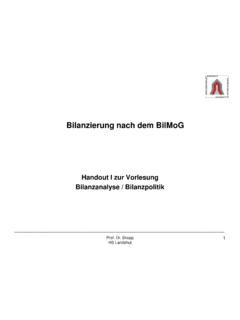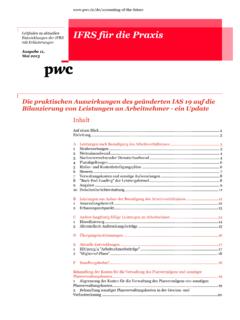Transcription of Classification of financial - EY
1 Applying ifrs . Classification of financial instruments under ifrs 9. May 2015. Contents 1. Introduction ..4. 2. Classification of financial assets ..4. Debt Equity instruments and 3. The business model assessment ..7. Holding-to-collect contractual cash flows ..8. Holding-to-collect contractual cash flows and selling ..8. FVTPL business models ..9. 4 Characteristics of the contractual cash flows of the The meaning of principal' ..10. The meaning of interest' ..10. Modified contractual cash flows ..12. Contractually linked instruments ..17. 5. Classifying financial liabilities ..20. 6. Designation as FVTPL ..21. 7. Designation of non-derivative equity instruments as at FVOCI ..21. 8 Reclassification of financial instruments ..22. 9 Effective date and transition ..25. Date of initial application ..25. Applying the business model assessment ..25. Applying the SPPI test ..25. Making and revoking designations ..26. Restatement of comparatives ..27. Derecognition prior to the date of initial application.
2 27. Transition adjustments and 1 May 2015 Applying ifrs Classification of financial instruments under ifrs 9. Appendix: Q&As to the Classification of financial instruments ..29. The business model assessment ..29. Level and granularity of the assessment ..29. Impact of sales on the assessment ..31. FVTPL business models ..40. The SPPI test ..41. Instruments without 'modified' cash flows ..41. De-minimis and non-genuine features ..43. Modified time value of money element ..44. Modified timing and amount of contractual cash flows ..46. Non-SPPI Features ..48. Subordination features, non-recourse and full-recourse loans ..52. Contractually linked instruments ..53. FVTPL and FVOCI Options ..57. Designation of a financial asset as at Designation of non-derivative equity instruments as at FVOCI ..57. Designation of a financial liability as at FVTPL ..59. Reclassification of financial assets ..61. Effective date and May 2015 Applying ifrs Classification of financial instruments under ifrs 9 2.
3 What you need to know ifrs 9 financial Instruments ( ifrs 9 or the Standard) introduces a new Classification model for financial assets that is more principles-based than the current requirements under IAS 39 financial Instruments: Recognition and Measurement. financial assets are classified according to their contractual cash flow characteristics and the business models under which they are held. Instruments will be classified either at amortised cost, the newly established measurement category fair value through other comprehensive income (FVOCI) or fair value through profit or loss (FVTPL). ifrs 9 will require an increased amount of judgement in performing the contractual cash flow characteristics test and the business model assessment. Entities are advised to analyse early the impact of the new Classification and measurement model as it could lead to higher profit or loss volatility and could have an impact on capital. The Classification and measurement requirements must be adopted with the other ifrs 9 requirements from 1 January 2018, with early application permitted.
4 3 May 2015 Applying ifrs Classification of financial instruments under ifrs 9. 1. Introduction In July 2014, the International Accounting Standards Board (the IASB or the Board) issued the final version of ifrs 9 financial Instruments, bringing together the Classification and measurement, impairment and hedge accounting aspects of the IASB's project to replace IAS 39 financial Instruments: Recognition and Measurement and all previous versions of ifrs 9. The Classification of financial instruments determines how they are accounted for and, in particular, how they are measured on an ongoing basis. This publication highlights The more principles-based approach of ifrs 9 requires the careful use of the factors that need to be judgment in its application. Some fact patterns have no simple and distinct considered in arriving outcome. We highlight in this publication, the factors that need to be considered at a conclusion. in arriving at a conclusion. Further issues and questions are likely to be raised during the course of implementation.
5 2. Classification of financial assets ifrs 9 has the following measurement categories in which financial assets are classified: Debt instruments at amortised cost Debt instruments at fair value through other comprehensive income (FVOCI). with cumulative gains and losses reclassified to profit or loss upon derecognition Debt instruments, derivatives and equity instruments at fair value through profit or loss (FVTPL). Equity instruments designated as measured at FVOCI with gains and losses remaining in other comprehensive income (OCI), , without recycling The Classification is based on both the entity's business model for managing the financial assets and the contractual cash flow characteristics of the financial asset. The synopsis below illustrates the thought process on which the Classification of financial assets is based. Illustration 2-1 Synopsis Classification May 2015 Applying ifrs Classification of financial instruments under ifrs 9 4. Illustration 2-2 below summarises the outcome of the thought process depicted in Illustration 2-1 above: Illustration 2-2 Outcome chart Classification Contractual cash flow characteristics test Pass Fail Held within a business model whose Amortised cost FVTPL.
6 Objective is to hold financial assets in order to collect contractual cash flows Business model Held within a business model whose FVOCI FVTPL. objective is achieved by both collecting (with recycling). contractual cash flows and selling financial assets financial assets which are neither held FVTPL FVTPL. at amortised cost nor at FVOCI. Conditional fair value option is elected FVTPL n/a1. Options Option elected to present changes in n/a2 FVOCI. fair value of an equity instrument not (no recycling). held for trading in OCI. 1. financial assets which fail the contractual cash flow characteristics test are measured at FVTPL. 2. Only debt instruments can pass the contractual cash flow characteristics test. The FVOCI. option does not apply to those instruments Debt instruments A debt instrument is generally measured at amortised cost if both of the following conditions are met: The asset is held within a business model whose objective is to hold assets in order to collect contractual cash flows The contractual terms of the financial asset give rise on specified dates to cash flows that are solely payments of principal and interest on the principal amount outstanding A debt instrument is normally measured at FVOCI if both of the following Apart from limited conditions are met: exceptions, only relatively The asset is held within a business model in which assets are managed to simple plain vanilla' debt achieve a particular objective by both collecting contractual cash flows and instruments qualify to be selling financial assets measured at amortised The contractual terms of the financial asset give rise on specified dates to cost or at FVOCI.
7 Cash flows that are solely payments of principal and interest on the principal amount outstanding The above requirements should be applied to an entire financial asset, even if it contains an embedded derivative. That is, in contrast with the requirements of IAS 39, a derivative embedded within a hybrid (combined) contract containing a financial asset host is not accounted for separately. A debt instrument that is not measured at amortised cost or at FVOCI must be measured at FVTPL. 5 May 2015 Applying ifrs Classification of financial instruments under ifrs 9. Notwithstanding the criteria for debt instruments to be classified at amortised cost or at FVOCI, as described above, an entity may irrevocably designate a debt instrument as measured at FVTPL at initial recognition. This is allowed if doing so eliminates or significantly reduces a measurement or recognition inconsistency (sometimes referred to as an 'accounting mismatch'). Such mismatches would otherwise arise from measuring assets or liabilities, or recognising the gains and losses on them, on different bases.
8 The IASB noted that the FVOCI measurement category is intended for debt instruments for which both amortised cost information and fair value information are relevant and useful. This will be the case if their performance is affected by both the collection of contractual cash flows and the realisation of fair values through The FVOCI measurement category may help some insurers achieve a greater level of consistency of measurement for assets held to back insurance liabilities under the new ifrs 4 insurance contracts It should also help to address concerns raised by preparers who expect to sell financial assets in greater volume than would be consistent with a business model whose objective is to hold financial assets to collect contractual cash flows and would, without this category, have to record such assets at FVTPL. The FVOCI category differs from the available-for-sale (AFS) category in IAS 39 in the following three key aspects. First, the AFS category was essentially a residual Classification and an unrestricted election.
9 In contrast to that, the FVOCI Classification under ifrs 9 reflects a business model evidenced by facts and circumstances and is neither a residual nor an election. Second, financial assets measured at FVOCI will be subject to the same impairment model as those measured at amortised cost. Accordingly, although recorded at fair value, the profit or loss treatment will be the same as for an amortised cost asset, with the difference between amortised cost and fair value recorded in OCI. until the asset is derecognised. Third, only relatively simple debt instruments will qualify for measurement at FVOCI. Equity instruments and derivatives Equity instruments and derivatives are normally measured at FVTPL. However, on initial recognition, an entity may make an irrevocable election (on an instrument-by-instrument basis) to present in OCI the subsequent changes in the fair value of an investment in an equity instrument within the scope of ifrs 9. This option only applies to instruments that are neither held for trading nor contingent consideration recognised by an acquirer in a business combination to which ifrs 3 applies.
10 For the purpose of this election, equity instrument' is used as defined in IAS 32 financial Instruments: Presentation. Although most gains and losses on investments in equity instruments designated at FVOCI will be recognised in OCI, dividends will normally be recognised in profit or loss. The IASB noted that dividends could represent a return of investment, instead of a return on investment. Consequently, the IASB. decided that dividends that clearly represent a recovery of part of the cost of the investment are not recognised in profit or Meanwhile, gains or losses recognised in OCI are never reclassified from equity to profit or loss. Consequently, there is no need to review such investments for possible impairment. 1. See paragraphs ifrs and 157. 2. See paragraphs ifrs 3. See paragraphs ifrs and ifrs (a). May 2015 Applying ifrs Classification of financial instruments under ifrs 9 6. 3. The business model assessment 4. The business model assessment is one of the two steps to classify financial assets.














